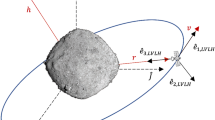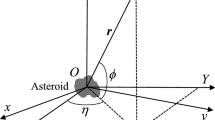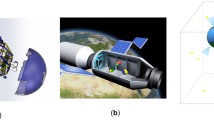Abstract
Accurate state estimations are perquisites of autonomous navigation and orbit maintenance missions. The extended Kalman filter (EKF) and the unscented Kalman filter (UKF), are the most commonly used method. However, the EKF results in poor estimation performance for systems are with high nonlinearity. As for the UKF, irregular sampling instants are required. In addition, both the EKF and the UKF cannot treat constraints. In this paper, a symplectic moving horizon estimation algorithm, where constraints can be considered, for nonlinear systems are developed. The estimation problem to be solved at each sampling instant is seen as a nonlinear constrained optimal control problem. The original nonlinear problem is transferred into a series of linear-quadratic problems and solved iteratively. A symplectic method based on the variational principle is proposed to solve such linear-quadratic problems, where the solution domain is divided into sub-intervals, and state, costate, and parametric variables are locally interpolated with linear approximation. The optimality conditions result in a linear complementarity problem which can be solved by the Lemke’s method easily. The developed symplectic moving horizon estimation method is applied to the Earth-Moon L2 libration point navigation. And numerical simulations demonstrate that though more time-consuming, the proposed method results in better estimation performance than the EKF and the UKF.
Similar content being viewed by others
Change history
11 February 2022
A Correction to this paper has been published: https://doi.org/10.1007/s42064-022-0136-2
References
Castelvecchi, D. Chinese satellite launch kicks off ambitious mission to Moon’s far side. Nature, 2018, 557(7706): 478–479.
Hill, K., Born, G. H., Lo, M. W. Linked, autonomous, interplanetary satellite orbit navigation (LiAISON) in lunar halo orbits. In: Proceedings of AAS/AIAA Astrodynamical Specialists Conference, 2005.
Hill, K., Born, G. H. Autonomous interplanetary orbit determination using satellite-to-satellite tracking. Journal of Guidance, Control, and Dynamics, 2007, 30(3): 679–686.
Sheikh, S. I., Pines, D. J., Ray, P. S., Wood, K. S., Lovellette, M. N., Wolff, M. T. Spacecraft navigation using X-ray pulsars. Journal of Guidance, Control, and Dynamics, 2006, 29(1): 49–63.
Psiaki, M. L. Absolute orbit and gravity determination using relative position measurements between two satellites. Journal of Guidance, Control, and Dynamics, 2011, 34(5): 1285–1297.
Cielaszyk, D., Wie, B. New approach to halo orbit determination and control. Journal of Guidance, Control, and Dynamics, 1996, 19(2): 266–273.
Ghorbani, M., Assadian, N. Optimal station-keeping near Earth-Moon collinear libration points using continuous and impulsive maneuvers. Advances in Space Research, 2013, 52(12): 2067–2079.
Hou, X. Y., Liu, L., Tang, J. S. Station-keeping of small amplitude motions around the collinear libration point in the real Earth-Moon system. Advances in Space Research, 2011, 47(7): 1127–1134.
Welch, G., Bishop, G. An introduction to the Kalman filter. University of North Carolina, 2001.
Julier, S. J., Uhlmann, J. K. Unscented filtering and nonlinear estimation. Proceedings of the IEEE, 2004, 92(3): 401–422.
Kandepu, R., Foss, B., Imsland, L. Applying the unscented Kalman filter for nonlinear state estimation. Journal of Process Control, 2008, 18(7–8): 753–768.
Kalman, R. E., Bucy, R. S. New results in linear filtering and prediction theory. Journal of Basic Engineering, 1961, 83(1): 95–108.
Abdelrahman, M., Park, S. Y. Simultaneous spacecraft attitude and orbit estimation using magnetic field vector measurements. Aerospace Science and Technology, 2011, 15(8): 653–669.
Xiong, K., Wei, C. L. Adaptive iterated extended KALMAN filter for relative spacecraft attitude and position estimation. Asian Journal of Control, 2018, 20(4): 1595–1610.
Soken, H. E., Hajiyev, C. UKF-based reconfigurable attitude parameters estimation and magnetometer calibration. IEEE Transactions on Aerospace and Electronic Systems, 2012, 48(3): 2614–2627.
Rao, C. V., Rawlings, J. B., Lee, J. H. Constrained linear state estimation—a moving horizon approach. Automatica, 2001, 37(10): 1619–1628.
Wang, S., Chen, L., Gu, D. B., Hu, H. S. An optimization based moving horizon estimation with application to localization of autonomous underwater vehicles. Robotics and Autonomous Systems, 2014, 62(10): 1581–1596.
Abdollahpouri, M., Takács, G., Rohal’-Ilkiv, B. Real-time moving horizon estimation for a vibrating active cantilever. Mechanical Systems and Signal Processing, 2017, 86: 1–15.
Zavala, V. M., Laird, C. D., Biegler, L. T. A fast moving horizon estimation algorithm based on nonlinear programming sensitivity. Journal of Process Control, 2008, 18(9): 876–884.
Chen, T. P., Foo, Y. S. E., Ling, K. V., Chen, X. B. Distributed state estimation using a modified partitioned moving horizon strategy for power systems. Sensors, 2017, 17(10): 2310.
Vandersteen, J., Diehl, M., Aerts, C., Swevers, J. Spacecraft attitude estimation and sensor calibration using moving horizon estimation. Journal of Guidance, Control, and Dynamics, 2013, 36(3): 734–742.
Huang, J. L., Zhao, G. R., Zhang, X. Y. MEMS gyroscope/TAM-integrated attitude estimation based on moving horizon estimation. Proceedings of the Institution of Mechanical Engineers, Part G: Journal of Aerospace Engineering, 2016, 231(8): 1451–1459.
Betts, J. T. Practical methods for optimal control using nonlinear programming. SIAM, 2001.
Soneda, Y., Ohtsuka, T. Nonlinear moving horizon state estimation with continuation/generalized minimum residual method. Journal of Guidance, Control, and Dynamics, 2005, 28(5): 878–884.
Bryson, A. E. Jr., Ho, Y. C. Applied Optimal Control. Hemisphere, 1975.
Szebehely, V. Theory of Orbits, the Restricted Problem of Three Bodies. Academic Press, 1967.
Peng, H. J., Jiang, X., Chen, B. S. Optimal nonlinear feedback control of spacecraft rendezvous with finite low thrust between libration orbits. Nonlinear Dynamics, 2014, 76(2): 1611–1632.
Peng, H. J, Wang, X. W., Shi, B. Y., Zhang, S., Chen, B. S. Stabilizing constrained chaotic system using a symplectic psuedospectral method. Communications in Nonlinear Science and Numerical Simulation, 2018, 56: 77–92.
Bellman, R. E., Kalaba, R. E. Quasilinearization and Nonlinear Boundary-value Problems. Elsevier, 1965.
Liu, X. F., Lu, P., Pan, B. F. Survey of convex optimization for aerospace applications. Astrodynamics, 2017, 1(1): 23–40.
Wang, X. W., Peng, H. J., Zhang, S., Chen, B. S., Zhong, W. X. A symplectic pseudospectral method for nonlinear optimal control problems with inequality constraints. ISA Transactions, 2017, 68: 335–352.
Wang, X. W., Peng, H. J., Zhang, S., Chen, B. S., Zhong, W. X. A symplectic local pseudospectral method for solving nonlinear state-delayed optimal control problems with inequality constraints. International Journal of Robust and Nonlinear Control, 2018, 28(6): 2097–2120.
Tomlin, J. A. Robust implementation of Lemke’s method for the linear complementarity problem. Complementarity and Fixed Point Problems, 1978, 55–60.
Acknowledgements
The authors are grateful for the financial support of the National Natural Science Foundation of China (Grant No. 11772074).
Author information
Authors and Affiliations
Corresponding author
Rights and permissions
About this article
Cite this article
Wang, X., Peng, H. A symplectic moving horizon estimation algorithm with its application to the Earth—Moon L2 libration point navigation. Astrodyn 3, 137–153 (2019). https://doi.org/10.1007/s42064-018-0041-x
Received:
Accepted:
Published:
Issue Date:
DOI: https://doi.org/10.1007/s42064-018-0041-x




